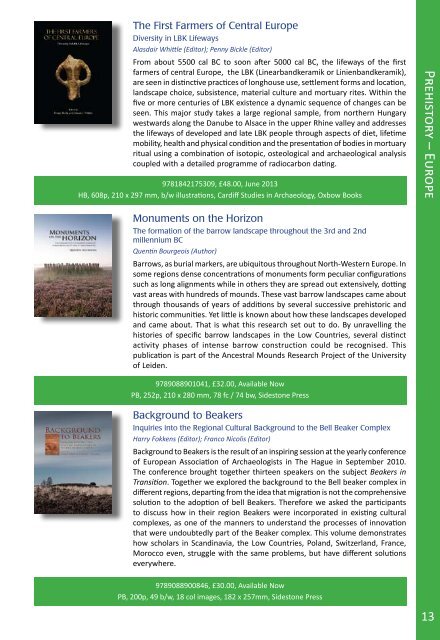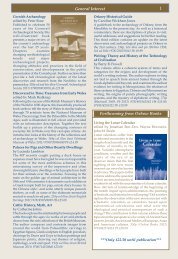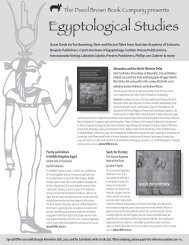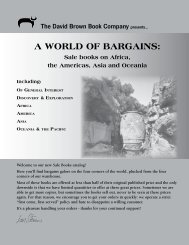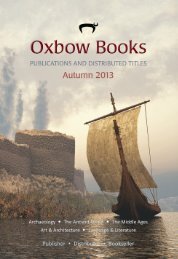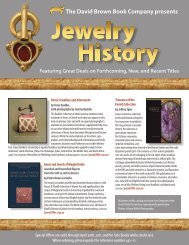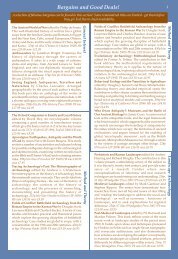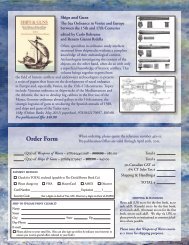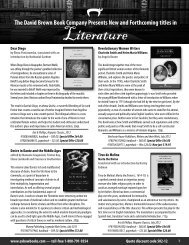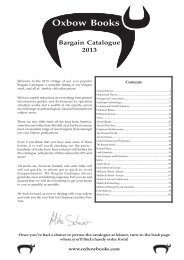Oxbow Spring 2013.pdf - Oxbow Books
Oxbow Spring 2013.pdf - Oxbow Books
Oxbow Spring 2013.pdf - Oxbow Books
Create successful ePaper yourself
Turn your PDF publications into a flip-book with our unique Google optimized e-Paper software.
The First Farmers of Central Europe<br />
Diversity in LBK Lifeways<br />
Alasdair Whittle (Editor); Penny Bickle (Editor)<br />
From about 5500 cal BC to soon after 5000 cal BC, the lifeways of the first<br />
farmers of central Europe, the LBK (Linearbandkeramik or Linienbandkeramik),<br />
are seen in distinctive practices of longhouse use, settlement forms and location,<br />
landscape choice, subsistence, material culture and mortuary rites. Within the<br />
five or more centuries of LBK existence a dynamic sequence of changes can be<br />
seen. This major study takes a large regional sample, from northern Hungary<br />
westwards along the Danube to Alsace in the upper Rhine valley and addresses<br />
the lifeways of developed and late LBK people through aspects of diet, lifetime<br />
mobility, health and physical condition and the presentation of bodies in mortuary<br />
ritual using a combination of isotopic, osteological and archaeological analysis<br />
coupled with a detailed programme of radiocarbon dating.<br />
9781842175309, £48.00, June 2013<br />
HB, 608p, 210 x 297 mm, b/w illustrations, Cardiff Studies in Archaeology, <strong>Oxbow</strong> <strong>Books</strong><br />
Prehistory – Europe<br />
Monuments on the Horizon<br />
The formation of the barrow landscape throughout the 3rd and 2nd<br />
millennium BC<br />
Quentin Bourgeois (Author)<br />
Barrows, as burial markers, are ubiquitous throughout North-Western Europe. In<br />
some regions dense concentrations of monuments form peculiar configurations<br />
such as long alignments while in others they are spread out extensively, dotting<br />
vast areas with hundreds of mounds. These vast barrow landscapes came about<br />
through thousands of years of additions by several successive prehistoric and<br />
historic communities. Yet little is known about how these landscapes developed<br />
and came about. That is what this research set out to do. By unravelling the<br />
histories of specific barrow landscapes in the Low Countries, several distinct<br />
activity phases of intense barrow construction could be recognised. This<br />
publication is part of the Ancestral Mounds Research Project of the University<br />
of Leiden.<br />
9789088901041, £32.00, Available Now<br />
PB, 252p, 210 x 280 mm, 78 fc / 74 bw, Sidestone Press<br />
Background to Beakers<br />
Inquiries into the Regional Cultural Background to the Bell Beaker Complex<br />
Harry Fokkens (Editor); Franco Nicolis (Editor)<br />
Background to Beakers is the result of an inspiring session at the yearly conference<br />
of European Association of Archaeologists in The Hague in September 2010.<br />
The conference brought together thirteen speakers on the subject Beakers in<br />
Transition. Together we explored the background to the Bell beaker complex in<br />
different regions, departing from the idea that migration is not the comprehensive<br />
solution to the adoption of bell Beakers. Therefore we asked the participants<br />
to discuss how in their region Beakers were incorporated in existing cultural<br />
complexes, as one of the manners to understand the processes of innovation<br />
that were undoubtedly part of the Beaker complex. This volume demonstrates<br />
how scholars in Scandinavia, the Low Countries, Poland, Switzerland, France,<br />
Morocco even, struggle with the same problems, but have different solutions<br />
everywhere.<br />
9789088900846, £30.00, Available Now<br />
PB, 200p, 49 b/w, 18 col images, 182 x 257mm, Sidestone Press<br />
13


